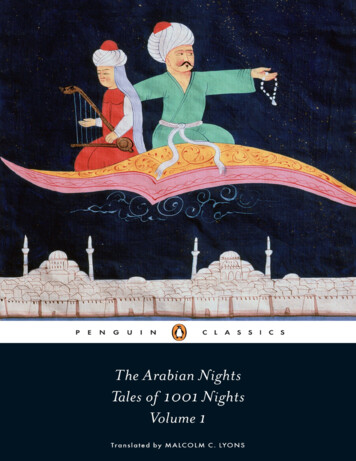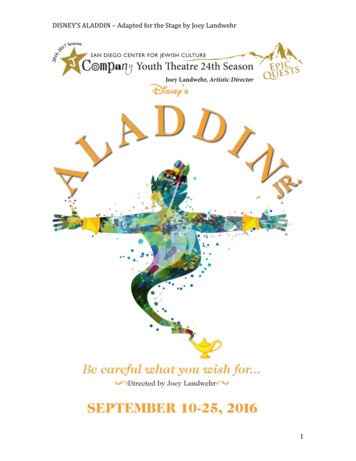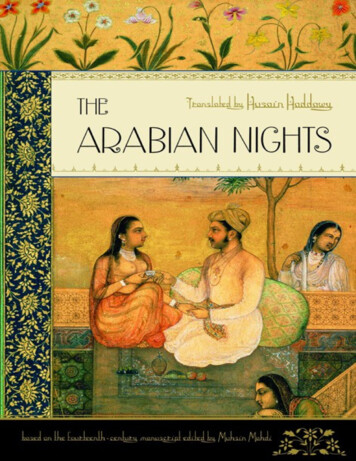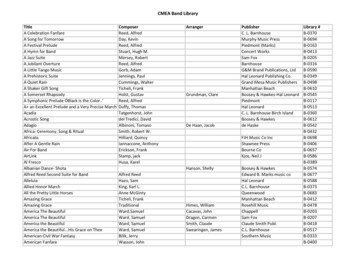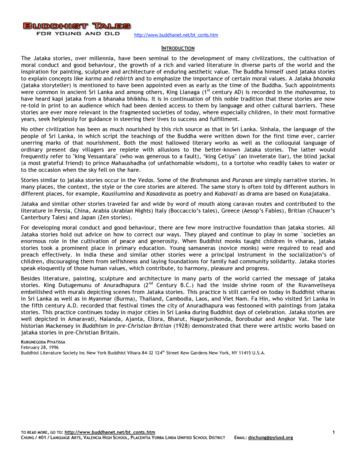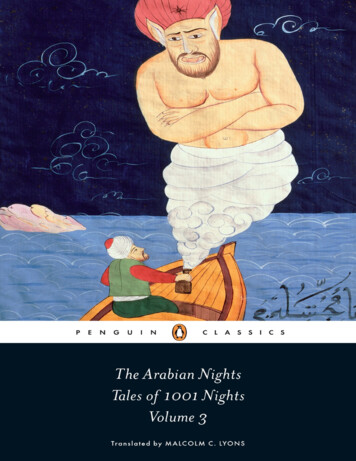
Transcription
THE ARABIAN NIGHTSTALES OF 1001 NIGHTSVOLUME 3MALCOLM C. LYONS,sometime Sir Thomas Adams Professor of Arabic atCambridge University and a life Fellow of Pembroke College, Cambridge,is a specialist in the field of classical Arabic Literature. His publishedworks include the biography Saladin: The Politics of the Holy War, TheArabian Epic: Heroic and Oral Storytelling, Identification and Identity inClassical Arabic Poetry and many articles on Arabic literature.URSULA LYONS,formerly an Affiliated Lecturer at the Faculty of OrientalStudies at Cambridge University and, since 1976, an Emeritus Fellow ofLucy Cavendish College, Cambridge, specializes in modern Arabicliterature.ROBERT IRWINis the author of For Lust of Knowing: The Orientalists andTheir Enemies, The Middle East in the Middle Ages, The Arabian Nights: ACompanion and numerous other specialized studies of Middle Easternpolitics, art and mysticism. His novels include The Limits of Vision, TheArabian Nightmare, The Mysteries of Algiers and Satan Wants Me.
Volume 3Nights 719 to 1001Translated by MALCOLM C. LYONS,with URSULA LYONSIntroduced and Annotated by ROBERT IRWINPENGUIN BOOKS
PENGUIN CLASSICSPublished by the Penguin GroupPenguin Books Ltd, 80 Strand, London WC2R 0RL, EnglandPenguin Group (USA) Inc., 375 Hudson Street, New York, New York 10014, USAPenguin Group (Canada), 90 Eglinton Avenue East, Suite 700, Toronto, Ontario, Canada M4P 2Y3(a division of Pearson Penguin Canada Inc.)Penguin Ireland, 25 St Stephen’s Green, Dublin 2, Ireland (a division of Penguin Books Ltd)Penguin Group (Australia), 250 Camberwell Road, Camberwell, Victoria 3124, Australia(a division of Pearson Australia Group Pty Ltd)Penguin Books India Pvt Ltd, 11 Community Centre, Panchsheel Park, New Delhi – 110 017,IndiaPenguin Group (NZ), 67 Apollo Drive, Rosedale, North Shore 0632, New Zealand(a division of Pearson New Zealand Ltd)Penguin Books (South Africa) (Pty) Ltd, 24 Sturdee Avenue, Rosebank,Johannesburg 2196, South AfricaPenguin Books Ltd, Registered Offices: 80 Strand, London WC2R 0RL, Englandwww.penguin.comThis translation first published in Penguin Classics hardback 2008Published in paperback 2010Translation of Nights 719 to 1001 copyright Malcolm C. Lyons, 2008Translation of ‘The story of Aladdin, or The Magic Lamp’ copyright Ursula Lyons, 2008Introduction and Glossary copyright Robert Irwin, 2008All rights reservedThe moral right of the translators and editor has been assertedText illustrations design by Coralie Bickford-Smith; images: Topkapi Palace Museum,Istanbul/The Bridgeman Art LibraryExcept in the United States of America, this book is sold subject to the condition that it shall not,by way of trade or otherwise, be lent, re-sold, hired out, or otherwise circulated without the
publisher’s prior consent in any form of binding or cover other than that in which it is publishedand without a similar condition including this condition being imposed on the subsequentpurchaserISBN: 978-0-14-194356-5
Editorial NoteIntroductionThe Arabian Nights: Nights 719 to 1001The Story of Aladdin, or The Magic LampGlossaryMapsThe ‘Abbasid Caliphate in the Ninth CenturyBaghdad in the Ninth CenturyCairo in the Fourteenth CenturyIndex of Nights and Stories
This new English version of The Arabian Nights (also known as TheThousand and One Nights) is the first complete translation of the Arabictext known as the Macnaghten edition or Calcutta II since RichardBurton’s famous translation of it in 1885–8. A great achievement in itstime, Burton’s translation nonetheless contained many errors, and evenin the 1880s his English read strangely.In this new edition, in addition to Malcolm Lyons’s translation of allthe stories found in the Arabic text of Calcutta II, Ursula Lyons hastranslated the tales of Aladdin and Ali Baba, as well as an alternativeending to ‘The seventh journey of Sindbad’, from Antoine Galland’seighteenth-century French. (For the Aladdin and Ali Baba stories nooriginal Arabic text has survived and consequently these are classed as‘orphan stories’.)The text appears in three volumes, each with an introduction, which,in Volume 1, discusses the strange nature of the Nights; in Volume 2,their history and provenance; and, in Volume 3, the influence the taleshave exerted on writers through the centuries. Volume 1 also includes anexplanatory note on the translation, a note on the text and anintroduction to the ‘orphan stories’ (‘Editing Galland’), in addition to achronology and suggestions for further reading. Footnotes, a glossaryand maps appear in all three volumes.
As often happens in popular narrative, inconsistencies andcontradictions abound in the text of the Nights. It would be easy toemend these, and where names have been misplaced this has been doneto avoid confusion. Elsewhere, however, emendations for which there isno textual authority would run counter to the fluid and uncritical spiritof the Arabic narrative. In such circumstances no changes have beenmade.
The Christians of medieval Europe believed Asia to be a region offabulous riches, strange marvels and wise sages. Cannibals and dogheaded men dwelt there and lambs grew from the soil as plants. TheTravels of Sir John de Mandeville, written sometime between 1357 and1371, gave an account of the marvels of Asia that was supposedly basedon the author’s journeyings. However, Mandeville’s Travels was no kindof Rough Guide to Asia, providing reliable information for prospectivetravellers. It was, rather, a work of entertainment in which interestingfacts were mixed in with even more interesting fictions. Some of thewonders conjured up by Mandeville are common to The Arabian Nightsand to The Seven Voyages of Sindbad. These include the giant bird knownas the rukh, the Amazon warrior women, the Magnetic Mountain, theFountain of Youth and the earthly paradise.In later centuries, Galland, Lane and Burton were to use theirtranslations of The Arabian Nights as vehicles for instructive glosses andfootnotes about Islamic and Arab manners and customs. But medievalChristian storytellers were not so interested in such things, and they hadlittle sense of the otherness of the Arab world. They did not compose oradapt stories featuring veiled women, harems, eunuchs and camels.There seems to have been no attempt to produce a translation of theNights that might have served any educational purpose. Instead,
individual storytelling items were absorbed piecemeal by medievalEuropean romancers and added to their fictional repertoire. Detachedfrom Shahrazad’s frame, such plot motifs, images or accessories – forexample, the flying carpet – even reached as far as Iceland.The unfinished ‘Squire’s Tale’ in Chaucer’s Canterbury Tales (1387–1400) provides one example of how all sorts of bits and pieces weretaken from the Nights and other Oriental sources, yet the story as awhole is unmistakably European and reveals no interest at all in the realOrient. In Tartarye (the Mongol lands) there was a great king calledCambyuskan. An envoy from Arabia brought him gifts, including a horseof brass, a mirror, a gold ring and a sword. The mirror and the ring werefor the king’s daughter Canacee. The mirror allows the viewer to seedanger and to detect falsehood in a woman. The sword can cut througharmour and deliver wounds that cannot be cured save by the applicationof the flat of the same sword. The ring permits its wearer to understandthe language of birds; hence Canacee is able to hear a female falconlament about how she has been deserted by a tercel (male hawk).Canacee nurses the bird, which has swooned from grief, and, shortlyafter this episode, ‘The Squire’s Tale’ breaks off.It is impossible to know how the story as a whole would havedeveloped further and what part the horse, mirror and sword wouldhave played in it. However, the deserted female falcon features in theNights stories of Ardashir and Hayat al-Nufus and of Taj al-Muluk andPrincess Dunya. From the Nights tales we can deduce that Canacee,having heard the female falcon’s story, will come to distrust all men andrebuff their approaches, until some prince completes the story byshowing how the male hawk did not deliberately abandon the female,
but was seized by a bigger raptor, such as a kite. Once Canaceeunderstands the full story, she will accept the prince’s suit.The mechanical horse and the magic mirror that feature in ‘TheSquire’s Tale’ also have their precursors in Nights stories. But this is notthe place to track down and examine each and every example of Arabstories and images that appeared in the romances of medieval andRenaissance Europe. Orlando Furioso, the mock-heroic epic composed byLudovico Ariosto and published in 1532, provides a striking example ofthe adaptation of a Nights story, almost certainly via an Italianintermediary source. One of the great classics of European literature, it isset in the time of Charlemagne and recounts the struggles of Orlando(Roland) and others of Charlemagne’s paladins against the Saracens andpagans. Their destinies cross with those of distressed damsels, sorcerersand monsters. In Canto 28, an innkeeper recounts to Rodomont the storyof two kings, Astolfo and Iocondo, who were betrayed by their wiveswith a knave and a dwarf respectively. Eventually the kings accept thepropensity of women to be unfaithful. Rodomont, having listened to theinnkeeper, is forced to accept that there is no limit to women’s wiles.Evidently the innkeeper’s story is an adaptation of the story with whichthe Nights opens, the tale of how Shahriyar and Shah Zaman werebetrayed by their adulterous wives and how, after a sexual encounterwith a woman, supposedly kept under guard by a jinni, they come torecognize that there is no such thing as a faithful woman.Arab, Persian and Turkish stories percolated into Europe, carried thereperhaps by sailors, merchants and prisoners of war. Spain and Sicilywere important as channels of transmission for Arab and Islamic culture,while another region where Muslim and Christian alternately fought one
another or lived together in uneasy coexistence was the Balkans. Thedegree to which Arabian Nights stories were known by Balkan and GreekChristians and transmitted by them prior to the publication of Galland’sFrench translation has yet to be properly investigated. But a version of‘Ali Baba and the Forty Thieves’ circulated in the Balkans (though ‘AliBaba’ was one of Galland’s ‘orphan stories’ for which no Arabic originalhas been found). Nights tales also circulated in Romania, and there was aVlach version of the story of Hasan of Basra. In 1835, AlexanderKinglake, author of the high-spirited travel masterpiece Eothen, set outfor the Holy Land and Egypt and, at one stage of his journey, took aGreek boat from Smyrna to Cyprus. One of the things that struck himwas the Greek crew’s fondness for long stories. These were ‘mostlyfounded upon oriental topics, and in one of them I recognized with somealteration, an old friend of The Arabian Nights. I inquired as to the sourcefrom which the story had been derived, and the crew all agreed that ithad been handed down unwritten from Greek to Greek.’ (Kinglake wenton to speculate, provocatively and foolishly, that the Nights as a wholemight have a Greek rather than an Oriental origin.) It is clear that someof the Nights stories circulated in oral form in Ottoman-occupied Greeceand came via Turkish versions.Romanians, Bulgarians, Albanians, Greeks and others could havebecome familiar with Nights stories via translations made from Arabic orSyriac. But it is perhaps more likely that they came to the stories inTurkish versions produced during the Ottoman period. Although themain corpus of The Arabian Nights was not translated into any Europeanlanguage until the eighteenth century, a substantial section had beentranslated into Turkish at a remarkably early date by Abdi in 1429 under
the title Binbir Gece (‘Thousand and One Nights’). Several othertranslations were later made into Turkish and these survive in variousmanuscripts. One in the British Library, apparently dating from theseventeenth century, has the ‘night stories’ told by Shahrazad, or rather‘Shehzad’ as she features in Turkish. These stories include the hunchbackcycle, but the ‘night stories’ are interleaved with ‘day stories’ related byanother narrator about the great Sufi saint Junayd. There is also the tenvolume Beyani manuscript of 1636, a translation of the Nights intoTurkish made on the orders of Murad IV. This manuscript was purchasedby Galland and brought by him to Paris; it is currently in theBibliothèque Nationale. It is possible that Galland consulted this Turkishmanuscript in order to supplement the material in the fifteenth-centuryArabic manuscript he was translating from.Galland’s translation was rather free and stories were edited in orderto conform to eighteenth-century French standards of decorum andrefinement. He also conceived of the publication of these stories ashaving a twofold purpose: they would not only give readers instructionabout the manners and customs of Oriental peoples, but those readerswould ‘benefit from the examples of virtues and vices’ contained in thestories. His French translation appeared in 1704–17 as Les Mille et unenuits and it was in turn swiftly translated into English, German, Italianand most of Europe’s leading languages. Adaptations, parodies, pastichesand other works inspired in one way or another by the Nights followedits publication. These included Jacques Cazotte’s Les Mille et une fadaises(1742), Crébillon fils’s Le Sopha (1742), Denis Diderot’s Les Bijouxindiscrets (1748), Voltaire’s Zadig (1748), Samuel Johnson’s Rasselas(1759), John Hawkesworth’s Almoran and Hamet (1761), James Ridley’s
Tales of the Genii (1764) and Cazotte’s Le Diable amoureux (1772). Themajority of these publications echoed Galland’s earnest purpose in thattheir narratives offered improving examples of the ‘virtues and vices’.France and, more precisely, Paris in the early eighteenth century had acentral role as the arbiter of taste and civilization. In his introduction toSpells of Enchantment: The Wondrous Fairy of Western Culture (1991), JackZipes, a leading authority on the history of the fairy tale, having notedthis, goes on to remark of Galland’s translation that ‘the literary fairytale became an acceptable social symbolic form through whichconventionalized motifs, characters, and plots were selected, composed,arranged, and rearranged to comment on the civilizing process and tokeep alive the possibility of miraculous change and a sense ofwonderment’. In the centuries that followed the French publication ofthe Nights, the stories were imitated, parodied and emulated. Somewriters imitated the manner; others merely borrowed a few Orientalprops or phrases. Words such as ‘carbuncle’, ‘talisman’ and ‘hieroglyphic’and phrases such as ‘Barmecide feast’ and ‘Aladdin’s cave’ were part ofthe common stock of literary bric-à-brac from a cultural attic. In moremodern times, writers have played intertextual games with the originalstories. Often overt or covert reference to the Nights has been used as akind of literary echo chamber in order to give depth to a more modernstory.For some eighteenth-century authors, the stories of the Nights were notmoralistic enough and they laboriously ‘improved’ them; for others inthe nineteenth and twentieth centuries, the stories were not eroticenough. From the second half of the nineteenth century onwards, theexistence of The Arabian Nights was also to serve as a kind of licensing
authority, permitting literary fantasy, eroticism and violence. Later, fromthe mid twentieth century onwards, there have been many attempts bywomen writers to redress the injustice of Shahriyar’s treatment ofwomen and his threat to execute Shahrazad as well as to reply to thefairly pervasive misogyny of the medieval Arab stories.Translated versions of the Nights influenced in different ways suchwell-known writers as Joseph Addison, Samuel Johnson, Voltaire,William Beckford, Samuel Taylor Coleridge, Marcel Proust, Jorge LuisBorges and John Barth (and I have discussed the nature of the variousinfluences in my Arabian Nights: A Companion, 2004). The account of theinfluence of the Nights that follows will concentrate on a small handfulof selected examples from British and French literature, but, of course,the influence of the Nights spread more widely and any trulycomprehensive account of its influence would also need to discuss suchfigures as the Germans, Johann Wolfgang Goethe, Hugo vonHofmannstahl and Ernst Junger, the Danes Adam Oehlenschläger andHans Christian Andersen, the Italian Italo Calvino and the JapaneseYukio Mishima. It would also cover the impact of the Nights on modernArabic literature. In the Arabic-speaking world, the Nights, because of itscolloquial style, frequently incorrect Arabic and occasional bawdiness,used not to enjoy a high reputation. However, from the twentiethcentury onwards and following the acclamation of Western writers andintellectuals, many of the Arab world’s most famous writers havechampioned the Nights, praised the liberating qualities of imaginativefiction and pastiched its themes. They include Tawfiq al-Hakim, TahaHussein, Jabra Ibrahim Jabra, Naguib Mahfouz and Edwar Kharrat. ‘Weare a doomed people, so regale us with amusing stories’ is the bitter
reflection of the narrator in the Sudanese writer Tayeb Salih’s Season ofMigration to the North (originally published in Arabic in 1966). Thisremarkable novel – one of the finest, perhaps the finest ever to have beenwritten in Arabic, about traditional values, colonialism, cross-culturalsexual encounters and much else – draws complex parallels with theNights, its protagonist a modern avatar of Shahriyar, driven to kill thewomen with whom he sleeps.In eighteenth-century Britain, the influence the Nights exercised onyoung people, some of whom were destined to go on to becomenovelists, was redoubled by the many imitations and pastiches that werepublished. These included John Hawkesworth’s aforementioned Almoranand Hamet (1761), William Beckford’s Vathek (1786) and ThomasGueulette’s early eighteenth-century, mock-Oriental Tartar, Moghul andChinese tales (written in French, but translated into English). But oneEnglish mock-Oriental story collection was of particular importance. Thiswas Tales of the Genii: or The Delightful Lessons of Horam, the Son of Asmar(1764) by the Reverend James Ridley. In this book, Ridley, who hadserved as an army chaplain in India, sought to promote ‘the truedoctrines of morality under the delightful allegories of romanticenchantment’. Those ‘true doctrines’ were of course Christian andProtestant. Ridley’s tales contain a lot of sorcery, magicaltransformations, genii, richly decorated palaces and all the conventionalsettings and trappings of the Orient. His heroes and heroines passthrough many ordeals and unmask all sorts of enchantments in order todiscover virtues that are veiled by appearances. The book, with its heavyfreight of Christian doctrine and moralizing, does not read well today,but it was enormously popular in the eighteenth and nineteenth
centuries and, as we shall see, it helped form the youthful imaginationsof better writers.Responses to the Nights over the centuries were shaped by changes insociety and taste. The Romantics were less interested than theirpredecessors in the moral lessons to be drawn from the Arabian stories,but enthusiastic about the wonders of magic, the exotic, and the sublimequalities of the vast and wild. Moreover, the Nights came to be associatedwith childhood reading and the opening up of the imagination that camefrom it. ‘Should children be permitted to read romances, and relations ofgiants and magicians and genii?’ Coleridge asked (in a letter to ThomasPoole in 1797), before answering: ‘I know all that has been said againstit; but I have formed my faith in the affirmative. I know of no other wayof giving the mind a love of the Great and the Whole.’ (The firstselection of tales from the Nights made specifically for children waspublished by Elizabeth Newberry in 1791.)William Wordsworth’s The Prelude or, Growth of a Poet’s Mind (1850) isan autobiographical poem in blank verse, in which the poet searches forpast sources of joy and recalls his childhood, including his youthfulreading. In the course of this, he praises the authors of pulp fiction: ‘Yedreamers, then, / Forgers of lawless tales! we bless you then’. Hebelieved that Arabian and similar tales were ‘eminently useful in callingforth intellectual power’ (as expressed in a letter of 1845). In the fifthbook of The Prelude, he writes:A precious treasure had I long possessed,A little yellow, canvas-covered book,A slender abstract of the Arabian tales
The Brontës – Emily, Charlotte, Anne and Bramwell – all read theNights when young. Ridley’s Tales of the Genii also exercised a powerfulinfluence on their youthful imaginations and the four children calledthemselves the ‘Genii’. Charlotte and Bramwell constructed an imaginarykingdom called Angria and wrote stories about it, while Emily and Annecomposed poems about another imaginary kingdom, Gondal. Both thestories and the poems drew upon Oriental and pseudo-Oriental tales.‘I took a book – some Arabian tales.’ This description of what Jane didafter a conversation with Mr Brocklehurst at Gateshead is one of severalexplicit references to the Nights in Charlotte Brontë’s Jane Eyre (1847).To take another example, Rochester’s horse is called Mesrour – derivedfrom ‘Masrur’, the name of the eunuch who accompanies Harun alRashid on his nocturnal explorations of Baghdad in the Nights. Moreprofoundly, such incidental and trivial references are surely intended tosuggest that, in its broadest outline, Jane Eyre is patterned on the framestory of the Nights. Jane is a kind of reincarnation of Shahrazad, talkingand teaching for her future. Correspondingly, Rochester is Shahriyar, anembittered despot who distrusts women (though he is, of course, also akind of Bluebeard, presiding over a great house with a locked chamber).In fact, Jane refers to him as ‘sultan’. The novel is, in short, the story ofhow the autocratic sultan is tamed by a good woman (subsequently thetheme of so many women’s romances).Emily Brontë’s Wuthering Heights (1847) also contains many explicitreferences to the Nights, as Nelly Dean assumes the role of a latter-dayShahrazad, while Lockwood is a kind of avatar of Shahriyar. Early on inthe novel, Catherine pretends to herself that she is like a merchant withhis caravan – such as the merchant in the Nights story of the merchant
and the jinni – but whereas the merchant’s expedition leads him to adangerous encounter with the jinni, who wants to kill him, Catherine’sleads her to meet the demonic Heathcliff. Heathcliff is several timescompared to a ghoul. On the other hand, Nelly Dean fancies thatHeathcliff might be an Oriental prince in disguise. More important,perhaps, than specific references to the Nights, was the licence that theArabic stories conferred for the wildness and passion that characterizesthe storytelling of both Jane Eyre and Wuthering Heights.In Charles Dickens: A Critical Study (1898), the nineteenth-centurynovelist and essayist George Gissing wrote about Dickens’s novels in thefollowing terms:Oddly enough, Dickens seems to make more allusions to the Arabian Nights than to anyother book or author Where the ordinary man sees nothing but everyday habit, Dickensis filled with the perception of marvellous possibilities. Again and again he has put thespirit of the Arabian Nights into his pictures of life by the river Thames He sought forwonders amid the dreary life of common streets; and perhaps in this direction was alsoencouraged when he made acquaintance with the dazzling Eastern fables, and took themalternately with that more solid nutriment of the eighteenth-century novel.Dickens, who read the Nights as a boy, was delighted by the stories,but his pleasure in Oriental storytelling was also fuelled by his passionfor Ridley’s tales. As a child, Dickens composed a tragic drama, Misnar,The Sultan of India, based one of the stories in Tales of the Genii,essentially the story of an Indian prince’s struggle to retain his throneagainst challenges presented by his ambitious brother assisted by sevengenii and the illusions conjured up by them.The power of Ridley’s story stayed with Dickens throughout his life.Towards the end of Great Expectations (1861), Pip reflects on how,
without his foreknowledge, everything is slowly but inexorably movingin such a way to bring catastrophe suddenly upon his head: ‘In theEastern story, the heavy slab that was to fall on the bed of state in theflush of conquest was slowly wrought out of the quarry, the tunnel forthe rope to hold it in its place was slowly carried through leagues ofrock ’ The reference is to the story of Misnar and his wise counsellorwho design a pavilion with a great stone slab set above it to trap and killtwo evil enchanters. At one point in the The Old Curiosity Shop (1841),Dick Swiveller wakes up in a strange bed: ‘If this is not a dream, I havewoke up, by mistake, in a dream in an Arabian Night, instead of aLondon one.’ Likewise, David Copperfield, who as a schoolboy iscompelled by the domineering Steerforth to tell stories late at night,compares his fate to that of Shahrazad. (And, of course, since Dickensboth published many of his novels in serial form and gave readings fromthem, it would be natural for him to think of himself as a latter-day maleversion of Shahrazad.) It would be very easy to go on listing overt andcovert references to the Nights and to Ridley’s ersatz version elsewhere inDickens’s works. What is more important is the feel of the Nights storiesand their impalpable but pervasive influence over Dickens’s fantasticalplots with their moralizing outcomes. Enigmatic philanthropists cloakedin disguise walk the streets at night following in the footsteps of Harunal-Rashid. Baghdad is reconfigured as London, and the Dickensian city ofmysteries and marvellous possibilities teems with grotesque characterswho may be distant descendants of the hunchback or of the barber’sseven disabled brothers.In George Eliot’s Daniel Deronda (1876), in large part a novel aboutthe Jewish people and their future prospects, she nevertheless makes
frequent use of references to The Arabian Nights in order to heighten theOriental feel of the novel. In particular, the protagonist, Daniel Deronda,is repeatedly compared to Qamar al-Zaman, the prince who, because ofhis education, is suspicious of women (and in Lane’s translation is sohandsome that he is ‘a temptation unto lovers, a paradise to thedesirous’). Correspondingly, the Jewess Mira is compared to PrincessBudur, who is fated to marry Qamar al-Zaman. Throughout the novel,allusions to the Nights are used not only to suggest the Oriental, but alsothe sensual passion that is the theme of so many of its stories.For a long time, European and Japanese knowledge of The ArabianNights was mediated by Galland’s courtly French and there is a sense inwhich the Nights in the eighteenth and nineteenth centuries can beregarded as largely a work of French literature. Its influence on Frenchliterary culture was, if anything, more overpowering than its legacy inBritain. In his Souvenirs d’égotisme (1832), Stendhal wrote of the Nights: ‘Iwould wear a mask with pleasure. I would love to change my name. TheArabian Nights which I adore occupy more than a quarter of my head.’ Itwould probably be fruitless to search Le Rouge et le noir (1830) or LaChartreuse de Parme (1839) for plots or borrowed props. Nevertheless theNights, and in particular its stress on magical powers, did help shapeStendhal’s image of himself as a novelist. Late in life he awarded himselfmagical powers as a writer, including becoming another person (as allgood novelists should strive to do). He wanted to live like Harun indisguise. (He also wished for the ring of Angelica which conferredinvisibility in Ariosto’s Orlando Furioso.) The power to become invisible,to assume another’s identity, to read another’s mind – all these staples ofIslamic occultism and storytelling gave Stendhal metaphors for himself
as an observer of humanity and a writer.The Nights influenced the storytelling of Alexandre Dumas père at amore obvious and superficial level. His Le Comte de Monte-Cristo (1845–6) is a wonderful melodrama of imprisonment, escape, enrichment andrevenge, which was first published as a magazine serial. Dumas workedwith a vocabulary of Oriental fantasy images that was shared with hisreaders. In the novel, Edmond Dantès, wrongfully imprisoned as aBonapartist conspirator, escapes and, having discovered treasure on theisland of Monte-Cristo, returns to Paris to take revenge on those who puthim in prison.There are many overt references to the Nights in the novel, but themost sustained evocation of its Oriental matter comes in chapter thirtyone, in which a Baron Franz d’Epinay lands on Monte-Cristo on aventure to encounter smugglers or bandits. Having landed, heencounters a group of smugglers who are going to roast a goat. Theyinvite Franz to dine with them, but he can only join them if he is firstblindfolded. The place he is led to is compared by his guide to the cavesof Ali Baba. On being told that it is rumoured that the cave has a doorthat only opens to a magic password, Franz exclaims that he has‘definitely stepped off into a tale from the Thousand and One Nights’.When the blindfold is removed, he finds himself in a cave furnishedsumptuously in an Oriental style.He is greeted by a mysterious and strikingly pale man who introduceshimself as Sindbad the Sailor (but he is, of course, the Count of MonteCristo, alias Dantès, a Byronic figure who revels in mystery). WhereuponFran
Thousand and One Nights) is the first complete translation of the Arabic text known as the Macnaghten edition or Calcutta II since Richard Burton’s famous translation of it in 1885–8. A great achievement in its time, Burton’s translation nonetheless contained many

